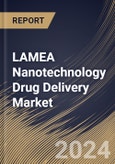The field of nanotechnology drug delivery is dynamic, marked by ongoing trends that shape its trajectory and influence the development of novel therapeutic strategies. These trends reflect the evolving landscape of nanomedicine and the continuous pursuit of innovations to address current challenges. The complexity of many diseases, especially cancer, often requires a multifaceted approach. Nanocarriers provide a versatile platform for combining chemotherapy agents, immunotherapeutics, and nucleic acid-based therapies within a single delivery system. This trend aligns with the broader paradigm of personalized and precision medicine, tailoring treatments to the unique characteristics of each patient and the specific requirements of their disease.
Additionally, the integration of diagnostics and therapeutics, known as theranostics, has become a trend in nanotechnology drug delivery. Theranostic nanoparticles combine therapeutic and imaging agents, allowing for simultaneous treatment and real-time monitoring of disease progression. This approach holds promise for optimizing treatment strategies, providing insights into treatment efficacy, and facilitating personalized medicine. Theranostic nanomedicines have been explored in various fields, including oncology, cardiovascular medicine, and neurology.
The LAMEA region faces various healthcare challenges, including the prevalence of infectious diseases. Infectious diseases can pose significant public health threats, and advanced and effective drug delivery systems are often needed to address these challenges. Nanotechnology in drug delivery involves using nanoscale materials to enhance the therapeutic properties of drugs, enabling targeted and controlled release. Increased government focus on healthcare infrastructure and initiatives to combat infectious diseases can lead to funding for research and development in advanced drug delivery technologies, including nanotechnology. Therefore, the growing number of infectious diseases in the LAMEA region is expected to boost the demand for this drug delivery in the upcoming years.
The Brazil market dominated the LAMEA Nanotechnology Drug Delivery Market, by Country in 2022, and would continue to be a dominant market till 2030; thereby, achieving a market value of $2,839.5 Million by 2030. The Argentina market is showcasing a CAGR of 11.2% during (2023 - 2030). Additionally, The UAE market would register a CAGR of 10.2% during (2023 - 2030).
Based on Formulation, the market is segmented into Polymer-Based Nanomedicine, Lipid-Based Nanomedicine, Nanocrystals, and Others. Based on Application, the market is segmented into Oncology & Hematology, Infectious Diseases, Orthopedics, Neurology, Immunology, Urology, and Others. Based on countries, the market is segmented into Brazil, Argentina, UAE, Saudi Arabia, South Africa, Nigeria, and Rest of LAMEA.
List of Key Companies Profiled
- AbbVie, Inc.
- Pfizer Inc.
- Johnson & Johnson (Johnson & Johnson Services, Inc.)
- Novartis AG
- Bristol-Myers Squibb Company
- AstraZeneca PLC
- Amgen, Inc.
- Merck KGaA
- Teva Pharmaceutical Industries Ltd.
- Sanofi S.A.
Market Report Segmentation
By Formulation- Polymer-Based Nanomedicine
- Lipid-Based Nanomedicine
- Nanocrystals
- Others
- Oncology & Hematology
- Infectious Diseases
- Orthopedics
- Neurology
- Immunology
- Urology
- Others
- Brazil
- Argentina
- UAE
- Saudi Arabia
- South Africa
- Nigeria
- Rest of LAMEA
Table of Contents
Companies Mentioned
- AbbVie, Inc.
- Pfizer Inc.
- Johnson & Johnson (Johnson & Johnson Services, Inc.)
- Novartis AG
- Bristol-Myers Squibb Company
- AstraZeneca PLC
- Amgen, Inc.
- Merck KGaA
- Teva Pharmaceutical Industries Ltd.
- Sanofi S.A.








